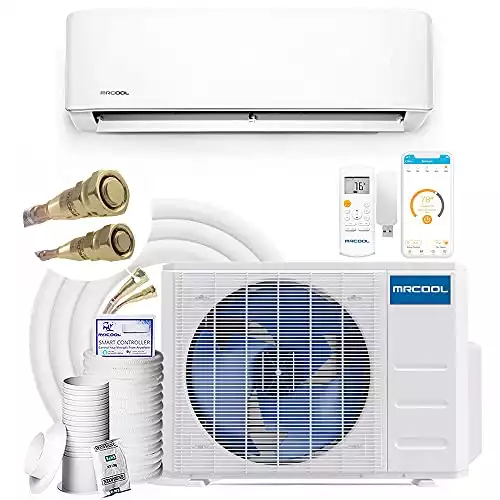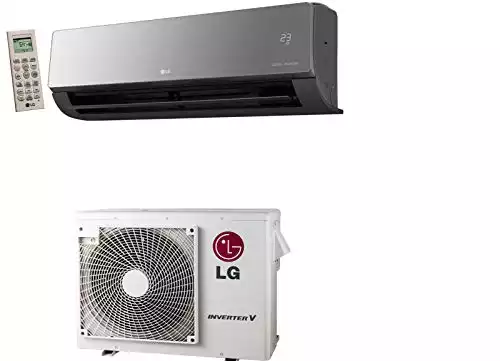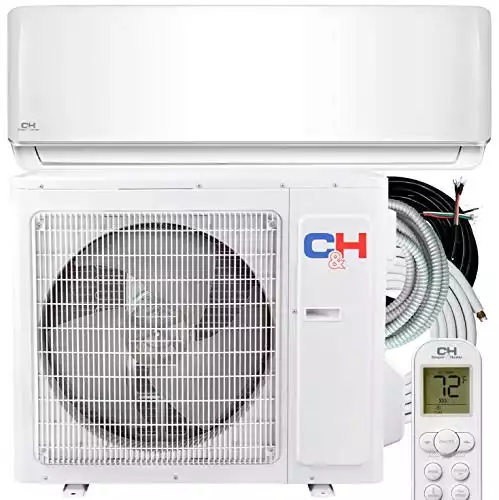Are you looking for flexible heating and cooling options for your home? Do you want a system that will ensure adequate cooling and heating in multiple areas of the house? If this is you, then you are in the right place. Mini Split systems have become quite popular over recent years, and it is no surprise.
These HVAC systems have high-level features and numerous benefits, as compared to the traditional options. They also incorporate technology, and in this technological era we live in, it will be a plus! So, you may be asking: “what are these mini-split systems, and how will they benefit me?
How do they differ from the central air HVAC units? Will they fix all my AC woes?” Below are mini-split systems explained in detail. Read on;
|
Primary Rating:
3.5
|
Primary Rating:
3.5
|
Primary Rating:
3.5
|
|
N/A
|
N/A
|
N/A
|
What is a Mini-Split?
Mini-Split systems, also known as ductless air conditioning systems or ductless mini-splits, are highly efficient and an advanced alternative to traditional AC options. They have a similarity with other AC options in that they both have an indoor air-handling unit and an outdoor condenser.
The one distinction between them is that mini-splits do not have ducts. While regular HVAC units exchange air between the indoor unit and the home or office through the ducts, ductless systems have the advantage that they can circulate air directly through the indoor unit without any ductwork.
Read also: Complete Guide to Spiral Ductworks.
A mini-split or ductless mini-split is a heating and cooling system that enables you to control temperatures and climates in various rooms.
It is referred to as split since it contains two primary components; a compressor attached to the outside of the home and an air handler installed inside the house. It is also versatile and flexible and can be used for residential, commercial, and institutional purposes.
What are the Components of a Mini-Split System?
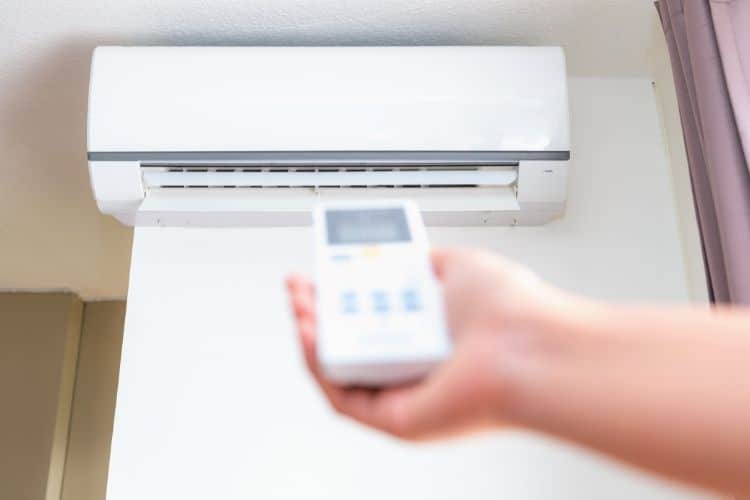
Mini-Split systems have four main components. These are:
Indoor Unit
These units can be wall-mounted or mounted on the ceiling. It is through these units that cool air is released into the home.
Condensing Unit
It is located outside the home or building. The condenser coil pumps air through the refrigerant lines connecting to the indoor units.
Refrigerant Lines
They connect the outdoor units to the indoor units. They are tiny tubes of cooling refrigerant that connect the units through a small hole in the wall or window, in rare cases. The refrigerant coolant is responsible for both cooling and heating.
Remote Control
The remote control or wall monitor controls the whole system and allows you to change the temperature and various modes according to what you prefer.
Read also: How to Camouflage a Mini-Split Unit to blend with your home decor.
Single-Zone Vs Multi-Zone Systems
Mini-Split systems are classified into two: Single-zone and multi-zone. So, what is the difference between these two systems?
Single-Zone Systems
A single-zone mini-split has one condenser and one air handler. It has one outdoor unit for each indoor unit. When you are cooling or heating several rooms with a single zone mini-split system, you will need an outdoor unit for every room.
The benefits of a single-zone mini-split system include:
- Lower carbon footprint.
- It will help reduce your energy bills.
- Less equipment is needed as in the multi-zone system.
- It is cheaper to install than a multi-zone mini-split system.
- It is easy to install than multi-zone systems. All you need is a small 3-inch hole in the wall to connect the indoor and outdoor units. In multi-zone systems, the process of running refrigerant lines is more invasive and complicated.
Multi-Zone Systems
These consist of two or more indoor mini-split units connected to one outdoor unit. One multi-zone mini-split can be connected to eight indoor units. It works like a single-zone system, but the difference is that it heats and cools more parts of the home or business.
They are common in apartments and basements, as they can serve multiple floors.
The benefits of a multi-zone mini-split system include:
- It has fewer outdoor units. Here, you will have a single compressor for multiple units, unlike in a single-zone system, where you will need several of them all over the house.
- Once installed, it is less expensive than a single-zone system.
- You will have complete control over the cooling and heating of the entire home.
- It offers an improved exterior home appearance. Since you will only need one outdoor unit for up to eight indoor units in multi-zone mini-split systems, you will not have several units all over the house. Having several bulky outdoor compressors outside the house can be pretty tricky and negatively impact the home’s appearance.
Split System Vs Ducted Systems
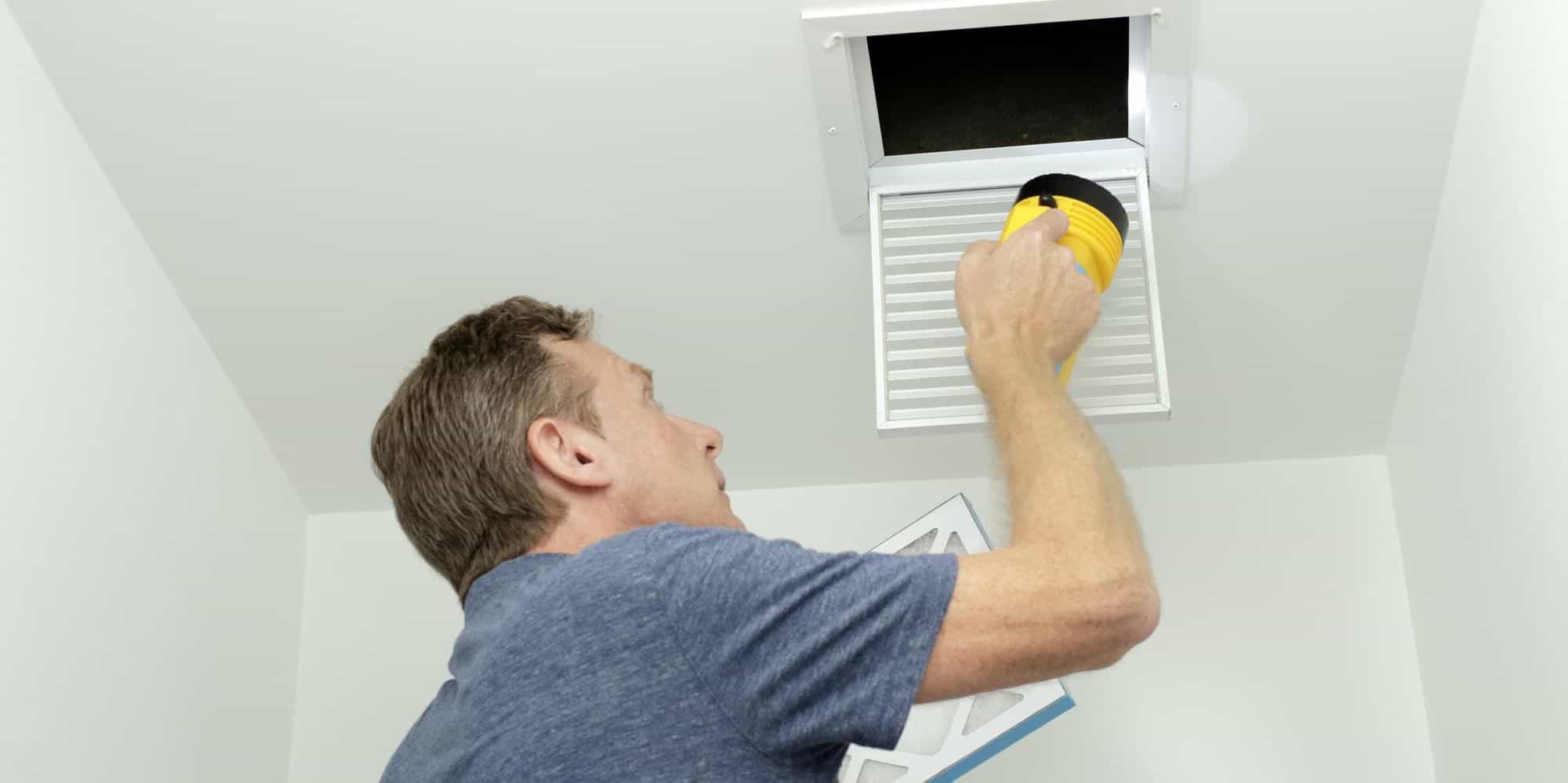
The main difference between these two comes down to the ducts. In a ducted system, the ducts distribute air from the AC unit to the house’s rooms. Here, the ducts are usually concealed, and only the vents will be visible.
The benefits of ducted systems are that they are efficient at cooling the entire home and are quieter than using multiple units. They also use discrete grilles; hence they will not be visible, as is the case with split air systems.
However, installing new ductwork is not cheap and can be pretty expensive. Also, the ducted system may require zoning permits in some areas; hence you should discuss it with your provider. They also have the potential for high energy loss.
This happens as some cool air escapes the ducts; thus, the AC will have to work harder. It will lead to more energy loss in the long term because as they age, the percentage of energy loss increases, which can be an issue.
How does a Mini-Split Work?
Mini-Split systems work simply and are not complicated. The four-step process includes:
The Hot Air is Sucked in
The air is taken from the room through the air handling unit. This is what you see mounted on the walls. The hot air then travels through several pipes to the condenser outside the home.
Energy is Transferred to the Coils
The hot and humid air then reaches the condenser, and the energy is transferred to its coils. The condenser has several coils containing a coolant. When the hot and humid air comes into contact with the coils, it transfers energy to them, turning the coolant liquid into gas.
The Coolant Gas is Converted Into Liquid
The gas is then sent to the compressor of the condenser unit. It is then recycled and turned back to liquid by an electrical process.
The Cool Air is Pumped Out
Here, the air is fed to the air handler and is ejected back into the room. Doing this repeatedly decreases the temperature of the room.
Mini-Split Systems Vs Central Air

Central air conditioning systems have been there for many years and are what most people are familiar with. However, they have some drawbacks that make mini-split systems more advantageous to you.
Drawbacks of Central Air Conditioners
Energy Loss
There are lots of energy losses that are associated with central air conditioners. This happens due to the ducting in these systems; hence a lot of energy is wasted. You will therefore get higher energy costs yearly as opposed to mini-split systems.
Ductwork is Required
To install air conditioner systems, ducting needs to be there. For older homes, this is no issue. However, some newer homes do not have ducting, which can be pretty expensive to install. This, in addition to purchasing the HVAC unit, can financially drain you.
Maintenance
Central AC systems need lots of maintenance all year round. You will need to do annual upkeep of the unit and clean the air ducts every 3-5 years. The ducts also need to be inspected for leaks annually. Therefore, if you do not follow through with these measures, you will have problems later on.
Cooling
Another disadvantage of central AC systems is that you will have to cool all the rooms, even though you do not use them. Therefore, you will need to pay to cool rooms that you no longer use, which will be a loss for you.
Advantages of a Mini-Split System
Mini-Split systems have numerous advantages. They include the following:
Compact
A mini-split only involves two components; an outdoor condenser or heat pump and an indoor air handler. Therefore, they do not take up a lot of space than other AC systems.
No Ducts Required
With mini-splits, you do need ducts installed. Therefore, no need to worry about the dirty ducts spreading particles and allergens into your home. Also, ducts lead to energy waste, hence a loss in performance. Therefore, with no ducts, you will get better performance.
Energy-Efficient
According to the United States Department of Energy, ducted systems have energy losses of up to 30% due to air leakage in the ducts, especially if they are in an unconditioned space like an attic.
Due to air leakage, the temperature inside and outside the room is equalized; hence the AC will work harder. For example, if the outside temperature is cold, the cool air will get through the ducts; therefore, the AC will have to use more energy to heat it.
Likewise, if the temperatures outside are high, the warm air will enter the room; hence the unit will have to work harder. Also, the windows and wall air conditioners use speed compressors that usually go full cycle and waste electricity in the process.
Ductless mini-split systems are more energy-efficient than their other counterparts. They also use several speed compressors that adjust to deal with the various weather conditions and the thermostat number set. Their invertor technology controls the speed of the compressor motor, which increases their efficiency.
Easy to Install
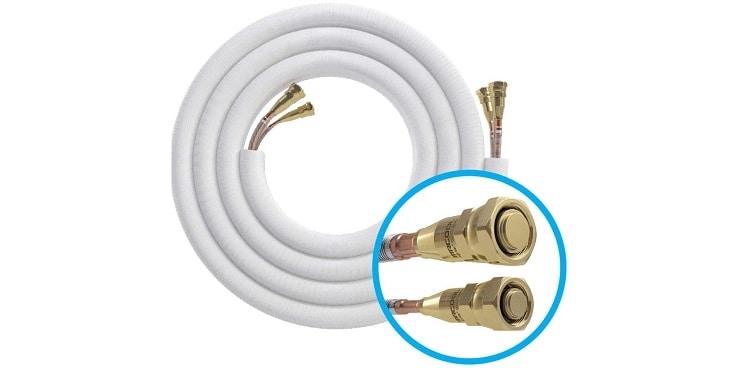
Installing a ducted system will take lots of time as it is pretty complicated. This is because the ducting will need to be routed along walls or inside them, taking days or weeks to do, based on the size of the home or business.
Ductless mini-split systems are easier to install. The work can be completed in under a day. Also, since multi-split systems use small holes, you will not need to rebuild the wall or repair the plasterwork, and if you do, it will be in infrequent circumstances.
Easy to Maintain
Ducted systems need lots of maintenance, which will require a professional. Ductless mini-splits have fewer components; hence they are easy to maintain. Also, you can do it yourself by cleaning the filters regularly.
They Offer Flexible Solutions
Mini-split systems are highly flexible and can be customized to suit different air conditioning needs. For example, a mini-split can serve up to five zones with just one condenser and indoor air handlers having their own thermostats.
As a homeowner, you will also have options for placing them according to your home’s interior design. This is because you can hang them on your wall, on the ceiling, or they can stand on the floor. You will therefore have the freedom to choose what works for you.
They Cost Less
Mini-split systems help you save on energy bills, as compared to ducted systems. The latter has a lot of energy losses, hence increasing your energy bills. The mini-split systems are cheaper as they use less power.
They are smaller, thus less heat loss through conduction, and the air travels for smaller distances. The air exchanger unit also transfers air directly from the condenser to the room, making it more efficient. The energy loss is eliminated; hence it will be cheaper for you.
Better Air Quality
You will get better air quality when using a mini-split system than the traditional AC systems. This is because conventional HVAC systems focus on keeping the entire home or business at a predetermined temperature.
The ducted systems also cannot prevent pollution from coming in, such as pollen, bacteria, and vehicle exhausts. Condensation occurs in the ducts; hence the debris can become toxic, especially to people with health conditions such as asthma.
Sadly, these contaminants are hard to get rid of, even with regular cleaning. This is where mini-split systems come in. They now come with filtration cartridges which can be easily washed and replaced. These systems help get rid of airborne particles and prevent them from getting into the home or business.
Multiple Modes of Operation
Mini-split systems have multiple modes of operation, which will be a plus for you. For example, they can dehumidify your room, coming in handy if you live in areas with moisture-laden climates. There are also sleep functions, a fan-only option, and automatic functionalities to choose from.
Quiet Operation
If you have dealt with traditional HVAC systems, you know how loud they can be. When you turn them off and on, they clunk and buzz, and as the ductwork ages, they tend to creak.
This can be pretty uncomfortable to deal with. Mini-Splits, on the other hand, have quiet operations due to their variable-speed motors. You will have difficulties hearing how the system works, which will be a plus for you if you need some quiet in your home or business environment.
Disadvantages of a Mini-Split System
Costly to Install
Generally, mini-splits save costs over time, but they can be pretty expensive to install at first. They are averagely priced at around $1750 per ton of their cooling capacity. This is quite expensive, as it is 30% more costly than central AC minus the ductwork.
Short Cycling May Occur
You need to install the mini-split correctly to prevent short cycling. A certified professional will help you get the correct location.
They are not Aesthetically Pleasing
Even though they are small, it is pretty hard to miss the air handler unit. It cannot be concealed; hence it can be aesthetically pleasing.
You Need to Hire a Qualified Installer
When it comes to mini-split systems, you will need the services of a qualified installer to make it work. Doing it on your own will lead to lots of disappointments. You may choose the wrong system, install it at the wrong location and even damage the home. This is why you need an experienced HVAC professional.
However, not all of them have worked with mini-splits; hence you have to be careful to choose one who is highly experienced in these matters. This will take time to do extensive research, and it will also cost you money.
Even though mini-split systems have their drawbacks, we still believe that their advantages outweigh their disadvantages. This makes them an incredible choice for anyone who needs efficient heating and cooling for their home or business.
Should I Get a Mini-Split System?

Ductless mini-split systems will benefit you if you are in any of the following situations:
- One or more members of the household have allergies.
- Your house does not have ductwork installed.
- New additions to the property including garages, games rooms, cellars, or extra rooms that need air conditioning.
- Downsizing a large home. Ductless systems are great for people who are looking to downsize as they will save money. Usually, people with ducted systems will need to shut HVAC grills linking the rooms together to stop heating and cooling their rooms. This, however, creates unequal pressure and increases the chances of mold buildup, which may be blown into the room when you restart the system. This can be quite a hassle. With ductless mini-split systems, you will no longer need to heat and cool rooms that you are not using. You will also prevent mold buildup in the process.
- Those with people in the home that have multiple needs. If your family is always fighting over the thermostat, then a mini-split may be the solution. It will create independent temperature zones in the different rooms. This will come in handy, more so if you have newborns and the elderly in your home.
- Those with rooms with heating and cooling problems. For example, if your small kitchen with a massive stove, it is highly likely to get hot and sweaty when cooking. This may prompt you to install a ductless mini-split system to help regulate the temperatures.
How Efficient are Mini-Split Systems?
The efficiency of mini-split systems is measured by a seasonal energy efficiency ratio (SEER). The higher the SEER levels, the more efficient the system is. In the United States, the mini-split federal requirements are a SEER rating of 13.0. There is also another energy rating to look out for, Energy Efficient Ratio (EER).
This is used to identify the energy usage per square foot of cooling. Most ductless systems have impressive SEER and EER ratings, ensuring that they efficiently regulate your home’s temperature.
Mini-Split systems are highly efficient and can save you up to 30% on your energy bill due to the absence of ductwork.
Our Top 3 Recommendations
These are some of the mini-split systems that we love based on the brand and their reliability. The bigger the brand, the better their track record and vice versa.
However, big brands will charge more, around $1000, while smaller brands will be cheaper than $1000. For big brands, MRCOOL and LG stand out, and they quite durable. For smaller brands, PIONEER and DAIKIN have great mini-split systems and at affordable prices.
MRCOOL DIY DIY-12-HP-115B 3rd Generation
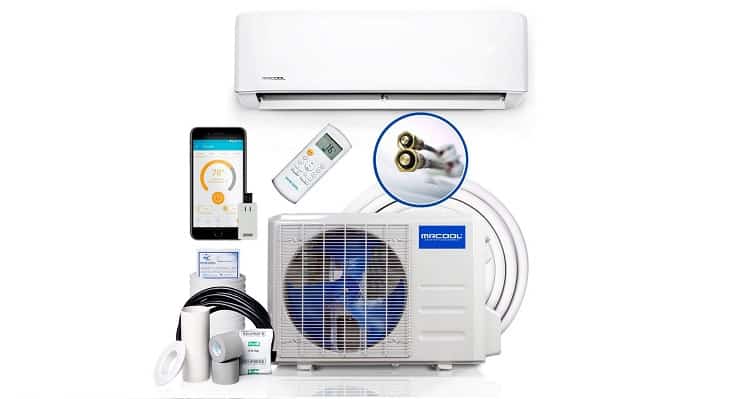
MRCOOL has decades of experience on mini-split systems; hence you can never go wrong with them. With one look at this 3rd gen model, you will love it! The specs are incredible, with 22 SER and 10 HSPF ratings.
Its heating efficiency is around 15% better than the average mini-split unit. It also has premium materials; thus, it will last for more than 20 years and has a seven-year warranty on the compressor. Being the best mini-split system in the market, it is more expensive than other comparable units.
When it comes to doing it yourself, the MRCOOL 3rd Generation Enhanced DIY is for making you. The included 25′ pre-charged line set allows you to install this innovative ductless system without special tools, equipment, or training.
LG Inverter V LS120HSV5
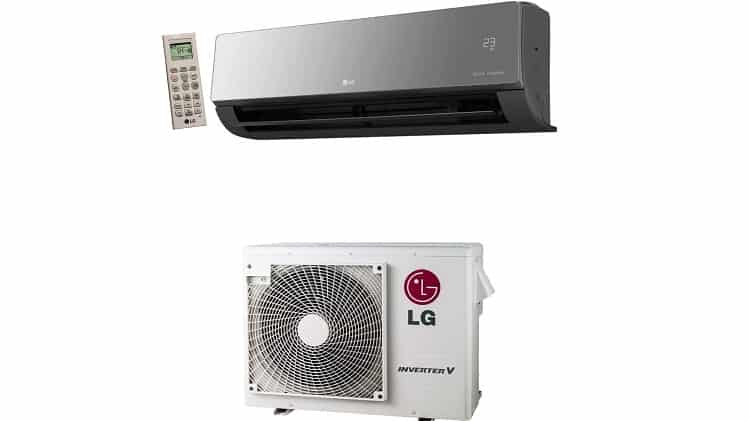
Also known as the quietest and reliable multi-system unit, LG did fantastic work on this one. It is the most reliable and quietest unit in the market, with 19dB on low setting and 22.7 SEER and 11.4 HSPF ratings.
It bagged the number two spot, and MRCOOL took 1st place because it is not as energy efficient as MRCOOL. With LG, reliability is prioritized over energy efficiency; hence, you will have little to no fixes once you buy it.
Features Four-way airflow creates a stronger, wider air flow to all corners of the room, reducing warm spots. Once the selected temperature is reached, the inverter compressor operates at low speed to maintain that comfort level.
Cooper & Hunter Single-Zone Ductless Mini-Split AC
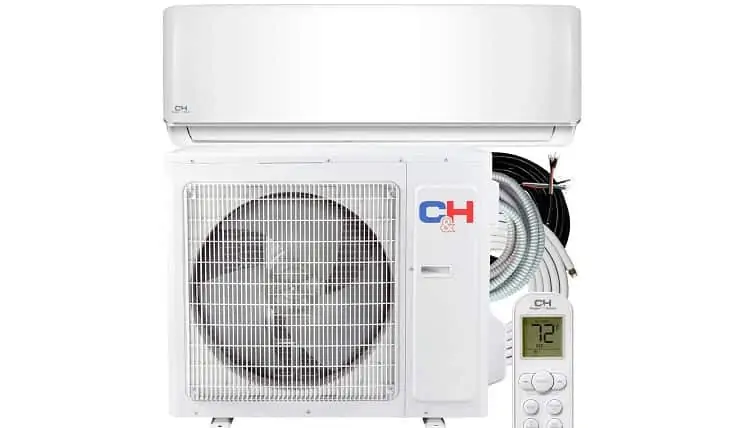
If you have a large room, then this is the best model for you. It delivers 36,000 BTU per hour; hence it can cool rooms over 1,000 square feet. This model is fantastic since it has a 21.5 SEER and costs less than 1,000. It also has 11.2 HSPF heaters, a WiFi connection, and has a DIY installation process. Amazing, right?
Mini-splits are heating and cooling systems that allow you to control the temperatures in individual rooms or spaces. With two main components — an outdoor compressor/condenser and an indoor air-handling unit they are easy to install and don't require a complex, expensive ductwork.
FAQs
Question: Can a Mini-Split Heat the Whole House?
Answer: The short answer is yes! You can use a mini-split unit to heat the whole house. However, there are some factors that you should consider. One of them is their size. Mini-Splits are tiny and have different power capabilities.
If you install a tiny system for you, you will get serious problems such as wear and tear, leading to early replacement. You need to ensure that it meets the demands of the home. However, when placed correctly, it will be able to heat the entire home efficiently.
Another factor to consider is their efficiency. They are highly efficient and are manufactured to deliver maximally with minimum effort. Therefore, do not underestimate their capabilities.
Question: Do I Need a Mini-Split for Every Room?
Answer: No, you do not. However, the outdoor unit attaches to multiple indoor units, which can be placed in the main areas. As a general rule, it is advised to install one air handler per room, especially if it is a high-traffic area.
For example, bedrooms, dining areas, and living rooms are appropriate to install your ductless mini-split systems as people spend most of their time there. Zoning the property will help you determine which areas need more cooling or heating than others. This will enable you to make better use of your mini-split system.
To determine if a room is eligible for a mini-split, you should ask yourself a few questions. These are:
Question: Is it Too Hot?
Answer: No one wants to stay in a room that is too hot, especially on a hot summer afternoon. It is not fun and will leave you sweaty for no reason. Here, installing a mini-split system will help cool the room.
Question: Is it Too Cold?
Answer: Are you always shivering, whether it is cold or not? Are you tired of layering up your clothing day in day out? If the room is too cold for you, you might consider installing a mini-split there.
Question: Can it be Fixed by Other Means?
Answer: In some cases, you will find that you do not need to install a mini-split to sort out the issue. For example, you might do some upgrades to replace broken windows or the old seals that allow air to get in, making the room cold.
However, if the upgrades do not work, you might have no other choice but to install the mini-split systems.
Question: How Long do Mini-Split Systems Last?
Answer: When properly maintained, it is estimated that ductless mini-splits can last up to 20 years. Most AC systems last for around 12-15 years; hence mini-splits outlast them, which will be a plus for you.
However, it will only last long if you do regular maintenance checks with a certified HVAC company. They will help you repair and take care of the system to avoid future problems.
The quality of the unit also plays a key role, as a high-quality system will last longer than one that is of lower quality. Not all ductless systems are equal; hence it is vital to be careful. Therefore, talk to a professional to help you choose the right mini-split system for your home or business.
Question: Can I Run a Mini-Split All Day Long?
Answer: You may be confused and wondering if it is okay to leave your mini-split running the entire day, especially in the warm spring and summer months. The truth is that there is no right or wrong answer to this question. Why is that? You may ask.
This is because you can run the mini-split as long or short as you prefer or need to. The mini-split will not harm your system, contrary to what most people think.
Therefore, if you run it all day long, it will not strain the system, as that is how they are designed to work.
Mini-Splits can also adjust themselves. This means that they can themselves on or off and can adjust automatically. They are highly energy-efficient, hence nothing to worry about.
If you are still not content, you can use a smart thermostat to control how long the mini-split will run. With a smart thermostat, you can program it according to your specifications. For example, if you want to turn it down when you are away at work or turn it up when it gets cold at night, it will do precisely that.
However, if you find that it is running continuously for no reason, you should call in a professional. Reasons for this could be faulty wiring or a lack of refrigerant. Do not hesitate to call in a professional to avoid worsening the situation.
Conclusion
Ductless mini-split systems are the go-to air conditioning systems for homes over recent years. With the information above, you will be able to upgrade from those loud and unsightly air conditioners to efficient and reliable mini-split systems.
They are simple and cheaper to install than ducted systems and will serve you for years. With the above guidelines, you will get the best value for money and enjoy the product until your golden years.
|
Primary Rating:
3.5
|
Primary Rating:
3.5
|
Primary Rating:
3.5
|
|
N/A
|
N/A
|
N/A
|
Continue reading related guides, reviews and comparisons:
- Best 12,000 BTU Mini Split Systems
- Best 18,000 BTU Mini Split Systems
- Best 24,000 BTU Mini Split Options
- Best 36,000 BTU Mini Split Systems
- Best Lowe’s Mini Split Models
- Best Home Depot Mini Split Models
- Blueridge Mini Split Review
- Best Fujitsu Mini Splits
- The Best 2.5 Ton Heat Pump Guide: Which is Right for You? - December 9, 2023
- Furnace Flame Sensor Replacement Guide 101: How To Replace Your Furnace Flame Sensor - May 6, 2022
- The Best 6000 BTU Mini Split Options - May 5, 2022

